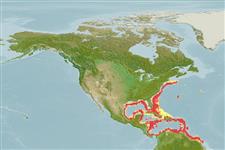Environment: milieu / climate zone / depth range / distribution range
Sinh thái học
Biển Tầng đáy biển sâu; không di cư; Mức độ sâu 80 - 1170 m (Ref. 1371), usually 160 - 640 m (Ref. 1371). Deep-water; 42°N - 4°N, 98°W - 50°W (Ref. 58452)
Western Central Atlantic: Georges Bank, New England to Suriname and French Guiana.
Length at first maturity / Bộ gần gũi / Khối lượng (Trọng lượng) / Age
Maturity: Lm 28.0 range ? - ? cm
Max length : 40.6 cm TL con đực/không giới tính; (Ref. 1371); 70.0 cm TL (female); common length : 30.0 cm TL con đực/không giới tính; (Ref. 1371); common length :45 cm TL (female); Khối lượng cực đại được công bố: 0.00 g
Các tia vây lưng cứng (tổng cộng) : 1; Các vây lưng mềm (tổng cộng) : 45 - 51; Tia cứng vây hậu môn: 0; Tia mềm vây hậu môn: 35 - 41; Động vật có xương sống: 51 - 53. Head rather long; mouth large; gill rakers short and thick, with blunt tips; pectoral fin tips reaching a vertical through anus in small fish but not in larger ones; overall color silvery white (Ref. 1371).
Offshore species which inhabit the outer part of the continental shelf and upper part of the slope. Feed at night when they come up towards the surface (Ref. 1371). Juveniles feed primarily on crustaceans (Ref. 58452). Adults' food consists primarily of fishes (particularly lantern fishes, sardines and anchovies) and, to a lesser extent, crustaceans and squids (Ref. 1371). Spawning occurs near the bottom at 330-550 m depth range from April to July in New England and from late spring to early autumn in the Gulf of Mexico and the Carribean Sea (Ref. 58452). Marketed fresh, frozen and smoked.
Cohen, D.M., T. Inada, T. Iwamoto and N. Scialabba, 1990. FAO species catalogue. Vol. 10. Gadiform fishes of the world (Order Gadiformes). An annotated and illustrated catalogue of cods, hakes, grenadiers and other gadiform fishes known to date. FAO Fish. Synop. 125(10). Rome: FAO. 442 p. (Ref. 1371)
IUCN Red List Status (Ref. 130435)
Threat to humans
Harmless
Human uses
Các nghề cá: buôn bán nhỏ
Các công cụ
Special reports
Download XML
Các nguồn internet
Estimates based on models
Preferred temperature (Ref.
123201): 7.1 - 20.5, mean 12.6 °C (based on 182 cells).
Phylogenetic diversity index (Ref.
82804): PD
50 = 0.5000 [Uniqueness, from 0.5 = low to 2.0 = high].
Bayesian length-weight: a=0.00759 (0.00453 - 0.01269), b=3.01 (2.86 - 3.16), in cm total length, based on LWR estimates for this species & (Sub)family-body (Ref.
93245).
Mức dinh dưỡng (Ref.
69278): 3.4 ±0.0 se; based on diet studies.
Generation time: 2.3 ( na - na) years. Estimated as median ln(3)/K based on 2
growth studies.
Thích nghi nhanh (Ref.
120179): Trung bình, thời gian nhân đôi của chủng quần tối thiểu là 1.4 - 4.4 năm (Assuming tmax > 3 and tm >=2; K=0.57; Fec=340,000).
Fishing Vulnerability (Ref.
59153): Low to moderate vulnerability (30 of 100).
Climate Vulnerability (Ref.
125649): Low to moderate vulnerability (29 of 100).
Nutrients (Ref.
124155): Calcium = 16.3 [7.2, 65.7] mg/100g; Iron = 0.484 [0.080, 1.352] mg/100g; Protein = 17.2 [15.7, 18.6] %; Omega3 = 0.252 [0.112, 0.506] g/100g; Selenium = 24.9 [9.8, 55.4] μg/100g; VitaminA = 11 [2, 52] μg/100g; Zinc = 0.301 [0.197, 0.490] mg/100g (wet weight);
